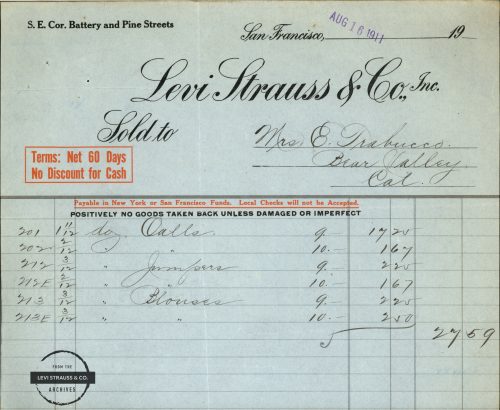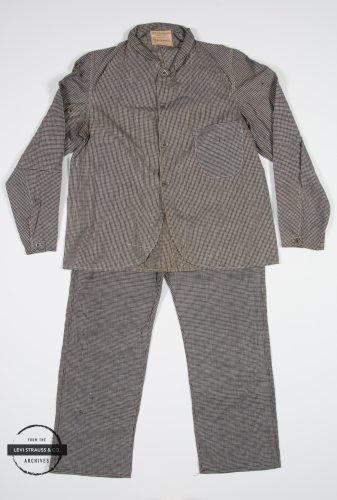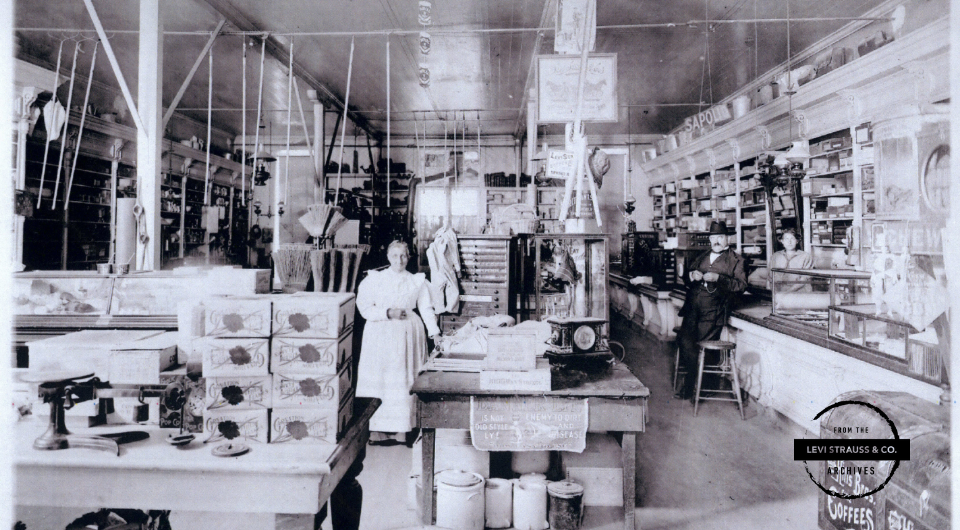This year Levi Strauss & Co. celebrates the 35th Anniversary of the first Original Levi’s® Store—a retail shop that opened in Vitoria, Spain in 1983. To mark this milestone, Tracey is exploring the evolution of LS&Co. retail.
Although we didn’t open our own retail shops until recently in our history, LS&Co. had wholesale customers—small shops—when Levi Strauss started his business in 1853. These stores were often simple, single-room general stores run by families who sold household essentials, from dishes to kitchenware and, of course, clothing. The shops served locals in the community including Gold Rush-era miners, hunters, carpenters or lumberjacks who needed supplies.
 The Hardie & Kennedy company was among LS&Co.’s earliest dry goods wholesale customers and was located in Foresthill in Placer County, California. Foresthill became a trading post that sat between the North and Middle forks of the American River where the gold-bearing gravel drew miners in droves in the 1850s. An 1858 handwritten bill for Hardie & Kennedy details purchases from check shirts to white hose and gray men’s drawers or pants.
The Hardie & Kennedy company was among LS&Co.’s earliest dry goods wholesale customers and was located in Foresthill in Placer County, California. Foresthill became a trading post that sat between the North and Middle forks of the American River where the gold-bearing gravel drew miners in droves in the 1850s. An 1858 handwritten bill for Hardie & Kennedy details purchases from check shirts to white hose and gray men’s drawers or pants.
A ledger that survived the San Francisco earthquake and fire of 1906 lists retailers that LS&Co. served from 1857 to 1902. Spanning the Asia Pacific region, the far reaching shop locations ranged from locations in Yokohama, Japan in 1870 to a store in Guaymas, Mexico in 1871. However, only retailers from 1873 on would have purchased clothing made specifically by LS&Co. since the company did not begin its own manufacturing until it received the patent for pocket riveting in May 1873.
By the 1880s, LS&Co. had relationships with retailers from Hawaii to Canada, among other locations, where customers

An unsold gingham set from the Trabucco store ca. 1905 to 1910.
could buy our clothes. Closer to company headquarters in San Francisco, we worked with places like the Poppe Store in Sonoma, California. The Poppe family hung our familiar Two-Horse Pull trademark from the ceiling of the one-room general store to remind customers that they could buy our genuine copper riveted overalls there.
By 1897, Mrs. Elenor Trabucco of Bear Valley, California numbered among LS&Co.’s retail customers. Elenor ordered clothing from LS&Co. through the early 1910s.The mercantile served customers until it closed around 1912. One memorable item in the Trabucco inventory was a two-piece gingham set that appeared in our 1905 catalog. The piece, unworn and unsold, is now part of the Levi Strauss & Co. Archives.
Pop-up shops, to use today’s terminology, may also have been among the places where the earliest LS&Co. wearers bought our clothes. South of San Francisco in Salinas, a find of rivets and artifacts dating to the early 1900s near a quarry revealed the site of what was likely a roadside stand where our riveted overalls were sold to Chinese laborers or others.
While our earliest LS&Co. shoppers typically bought our clothes in small general stores and family-run mercantiles, you could be assured of the highest quality if you purchased Levi Strauss & Co. brands.







